wheel size TOYOTA iQ EV 2013 Owners Manual (in English)
[x] Cancel search | Manufacturer: TOYOTA, Model Year: 2013, Model line: iQ EV, Model: TOYOTA iQ EV 2013Pages: 444, PDF Size: 7.34 MB
Page 212 of 444

2125-5. Using the driving support systems
CAUTION
Ō¢ĀThe ABS does not operate effectively when
ŌŚÅ The limits of tire gripping performance have been exceeded.
ŌŚÅ The vehicle hydroplanes while driving at high speed on wet or slick roads.
Ō¢Ā Stopping distance when the ABS is operating may exceed that of nor-
mal conditions
The ABS is not designed to shorten the vehicleŌĆÖs stopping distance. Always
maintain a safe distance from the vehicle in front of you, especially in the
following situations:
ŌŚÅ When driving on dirt, gravel or snow-covered roads
ŌŚÅ When driving with tire chains
ŌŚÅ When driving over bumps in the road
ŌŚÅ When driving over roads with potholes or uneven surfaces
Ō¢Ā TRAC may not operat e effectively when
Directional control and power may not be achievable while driving on slip-
pery road surfaces, even if the TRAC system is operating.
Do not drive the vehicle in conditions where stability and power may be lost.
Ō¢Ā When the VSC is activated
The slip indicator flashes. Always drive carefully. Reckless driving may
cause an accident. Exercise particular care when the indicator flashes.
Ō¢Ā Replacing tires
Make sure that all tires are of the specified size, brand, tread pattern and
total load capacity. In addition, make sure that the tires are inflated to the
recommended tire inflation pressure level.
The ABS, TRAC and VSC systems will not function correctly if different tires
are installed on the vehicle.
Contact your Scion dealer for further information when replacing tires or
wheels.
Ō¢Ā Handling of tires and the suspension
Using tires with any kind of problem or modifying the suspension will affect
the driving assist systems, and may cause a system to malfunction.
Page 216 of 444
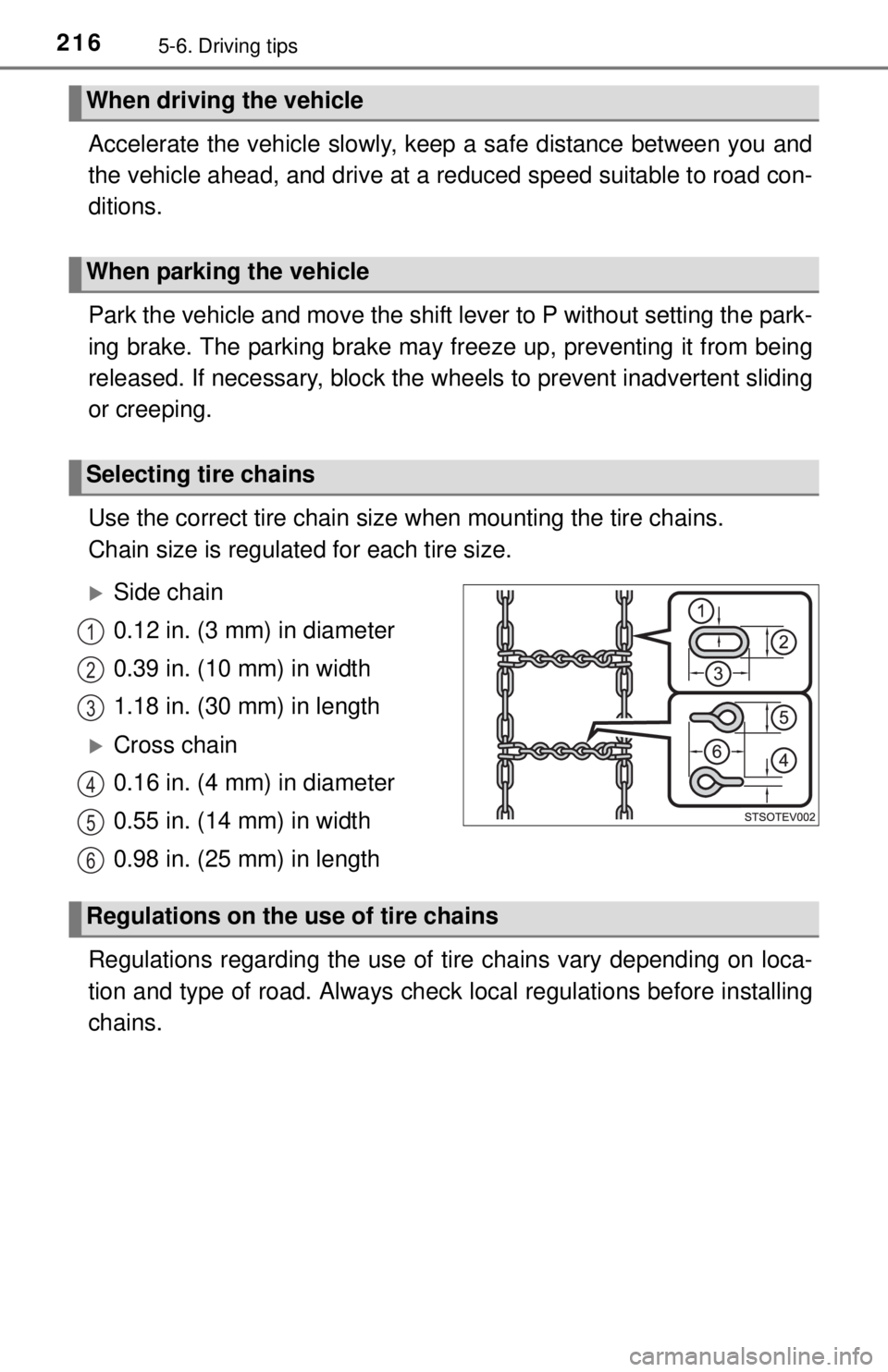
2165-6. Driving tips
Accelerate the vehicle slowly, keep a safe distance between you and
the vehicle ahead, and drive at a reduced speed suitable to road con-
ditions.
Park the vehicle and move the shift lever to P without setting the park-
ing brake. The parking brake may freeze up, preventing it from being
released. If necessary, block the wheels to prev ent inadvertent sliding
or creeping.
Use the correct tire chain size when mounting the tire chains.
Chain size is regulated for each tire size.
Regulations regarding the use of tire chains vary depending on loca-
tion and type of road. Al ways check local regulations before installing
chains.
When driving the vehicle
When parking the vehicle
Selecting tire chains
’üĄSide chain
0.12 in. (3 mm) in diameter
0.39 in. (10 mm) in width
1.18 in. (30 mm) in length
’üĄCross chain
0.16 in. (4 mm) in diameter
0.55 in. (14 mm) in width
0.98 in. (25 mm) in length
Regulations on the use of tire chains
1
2
3
4
5
6
Page 217 of 444
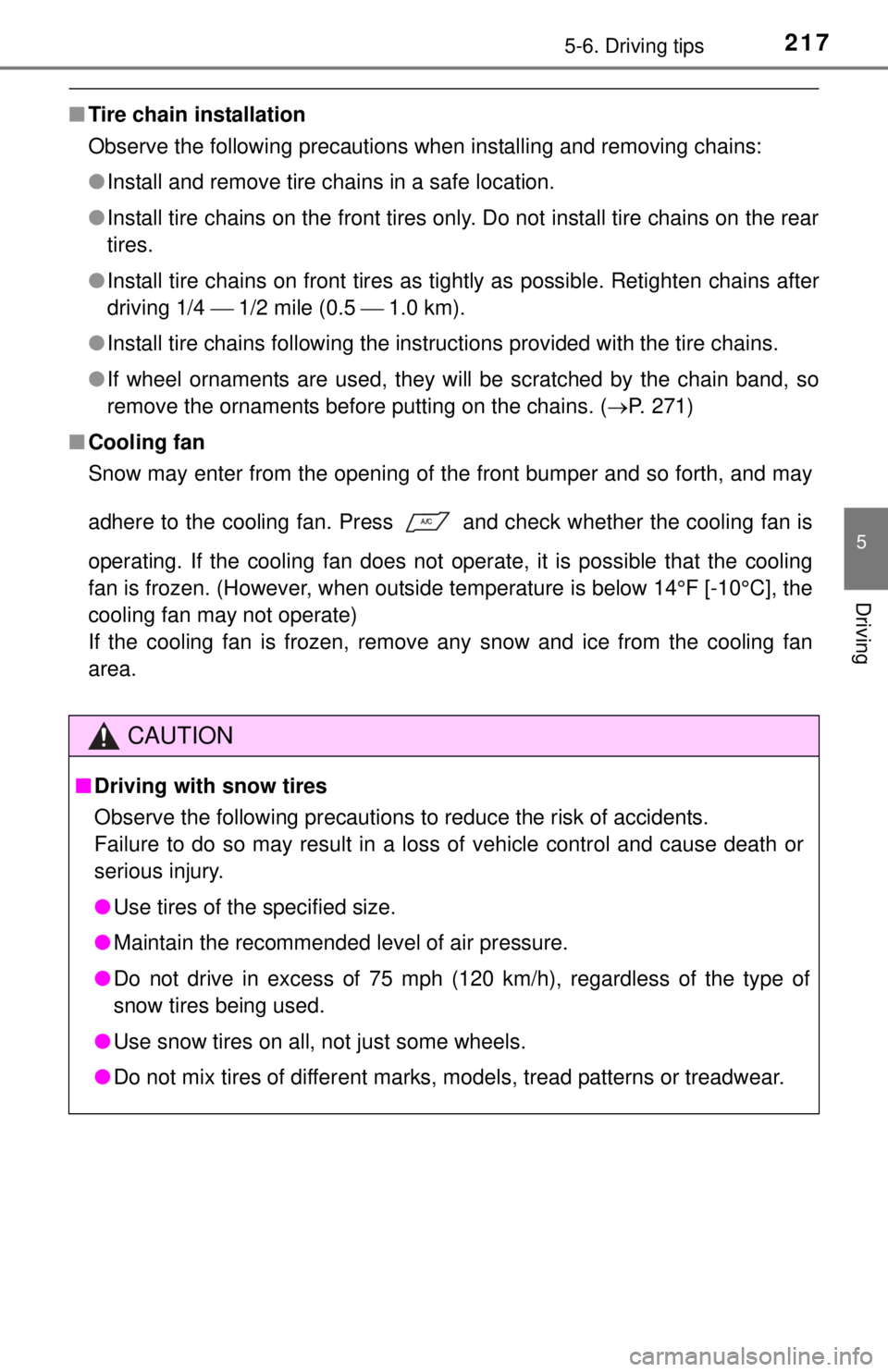
2175-6. Driving tips
5
Driving
Ō¢ĀTire chain installation
Observe the following precautions when installing and removing chains:
ŌŚÅInstall and remove tire chains in a safe location.
ŌŚÅ Install tire chains on the front tires only. Do not install tire chains on the rear
tires.
ŌŚÅ Install tire chains on front tires as tightly as possible. Retighten chains after
driving 1/4 ’éŠ 1/2 mile (0.5 ’éŠ 1.0 km).
ŌŚÅ Install tire chains following the instructions provided with the tire chains.
ŌŚÅ If wheel ornaments are used, they will be scratched by the chain band, so
remove the ornaments before putting on the chains. ( ’é«P. 271)
Ō¢Ā Cooling fan
Snow may enter from the opening of the front bumper and so forth, and ma\
y
adhere to the cooling fan. Press and check whether the cooling fan is
operating. If the cooling fan does not operate, it is possible that the cooling
fan is frozen. (However, when outside temperature is below 14┬░F [-10┬░C], the
cooling fan may not operate)
If the cooling fan is frozen, remove any snow and ice from the cooling fan
area.
CAUTION
Ō¢Ā Driving with snow tires
Observe the following precautions to reduce the risk of accidents.
Failure to do so may result in a loss of vehicle control and cause death or
serious injury.
ŌŚÅ Use tires of the specified size.
ŌŚÅ Maintain the recommended level of air pressure.
ŌŚÅ Do not drive in excess of 75 mph (120 km/h), regardless of the type of
snow tires being used.
ŌŚÅ Use snow tires on all, not just some wheels.
ŌŚÅ Do not mix tires of different marks, models, tread patterns or treadwear.
Page 287 of 444
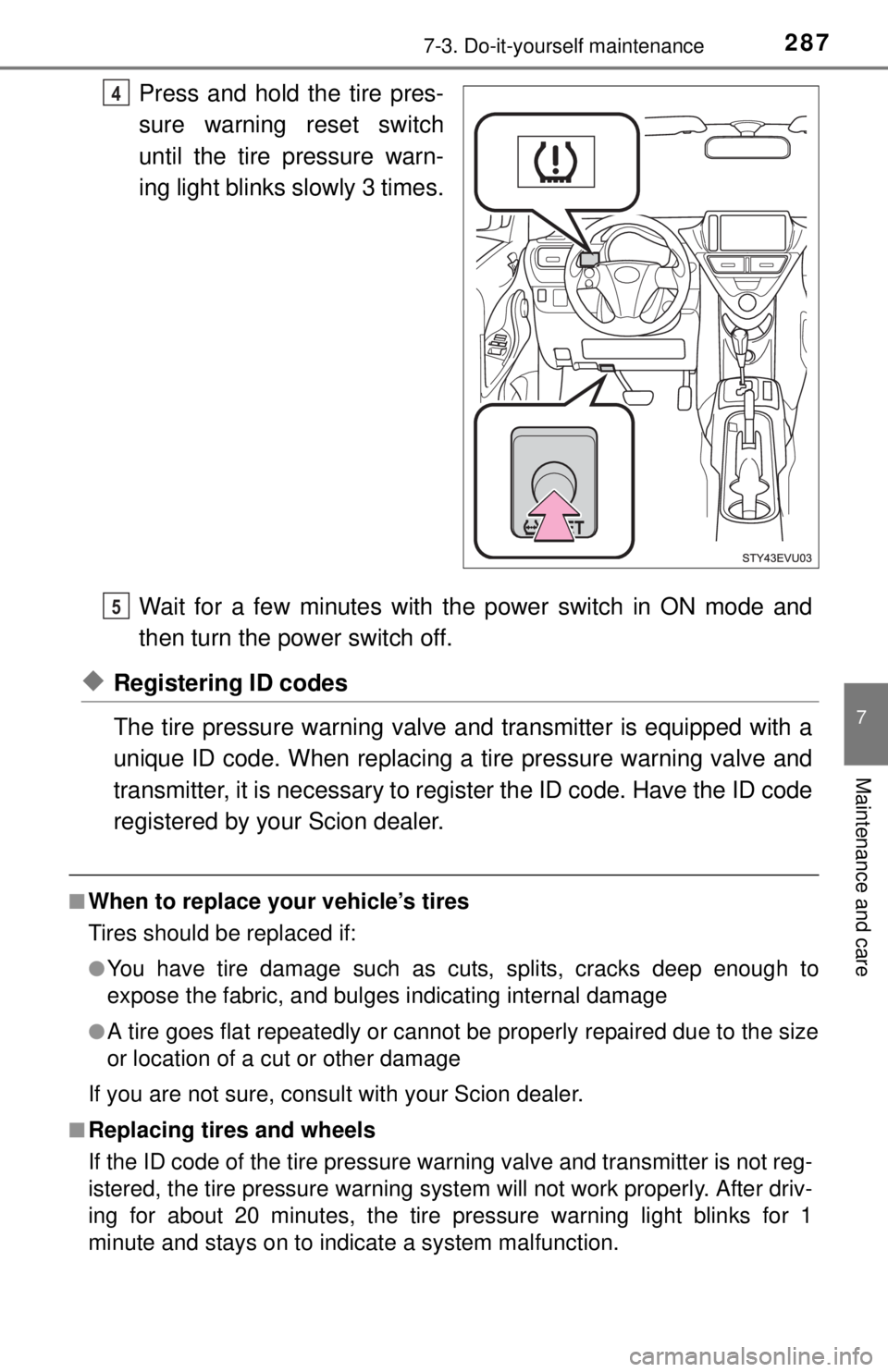
2877-3. Do-it-yourself maintenance
7
Maintenance and care
Press and hold the tire pres-
sure warning reset switch
until the tire pressure warn-
ing light blinks slowly 3 times.
Wait for a few minutes with the power switch in ON mode and
then turn the power switch off.
ŌŚåRegistering ID codes
The tire pressure warning valve and transmitter is equipped with a
unique ID code. When replacing a tire pressure warning valve and
transmitter, it is necessary to register the ID code. Have the ID code
registered by your Scion dealer.
Ō¢ĀWhen to replace your vehicleŌĆÖs tires
Tires should be replaced if:
ŌŚÅYou have tire damage such as cuts, splits, cracks deep enough to
expose the fabric, and bulges indicating internal damage
ŌŚÅA tire goes flat repeatedly or cannot be properly repaired due to the size
or location of a cut or other damage
If you are not sure, consult with your Scion dealer.
Ō¢ĀReplacing tires and wheels
If the ID code of the tire pressure warning valve and transmitter is not reg-
istered, the tire pressure warning system will not work properly. After driv-
ing for about 20 minutes, the tire pressure warning light blinks for 1
minute and stays on to indicate a system malfunction.
4
5
Page 288 of 444
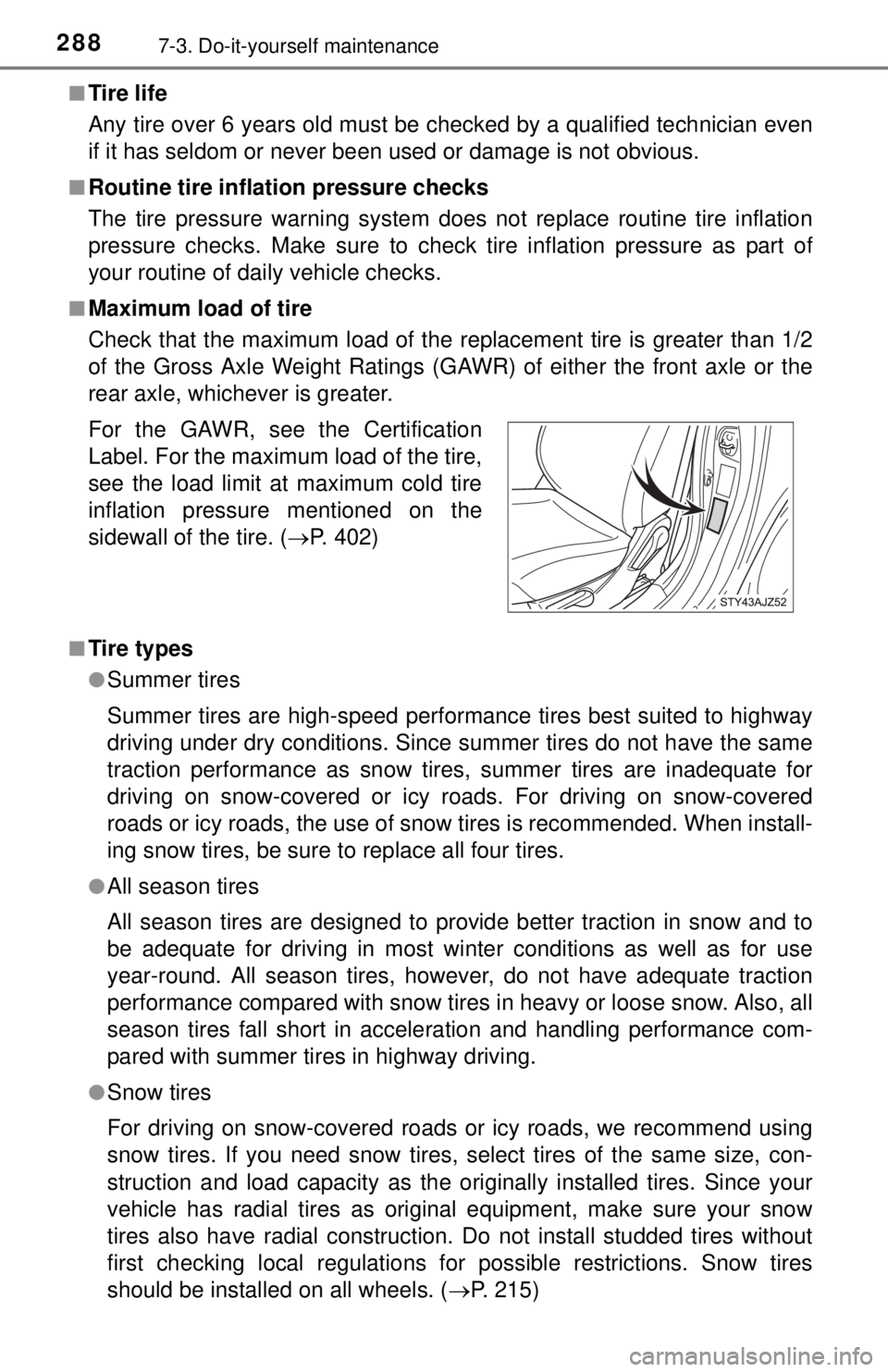
2887-3. Do-it-yourself maintenance
Ō¢ĀTire life
Any tire over 6 years old must be checked by a qualified technician even
if it has seldom or never been used or damage is not obvious.
Ō¢ĀRoutine tire inflation pressure checks
The tire pressure warning system does not replace routine tire inflation
pressure checks. Make sure to check tire inflation pressure as part of
your routine of daily vehicle checks.
Ō¢ĀMaximum load of tire
Check that the maximum load of the replacement tire is greater than 1/2
of the Gross Axle Weight Ratings (GAWR) of either the front axle or the
rear axle, whichever is greater.
Ō¢ĀTire types
ŌŚÅSummer tires
Summer tires are high-speed performance tires best suited to highway
driving under dry conditions. Since summer tires do not have the same
traction performance as snow tires, summer tires are inadequate for
driving on snow-covered or icy ro ads. For driving on snow-covered
roads or icy roads, the use of snow tires is recommended. When install-
ing snow tires, be sure to replace all four tires.
ŌŚÅAll season tires
All season tires are designed to provide better traction in snow and to
be adequate for driving in most winter conditions as well as for use
year-round. All season tires, however, do not have adequate traction
performance compared with snow tires in heavy or loose snow. Also, all
season tires fall short in acceleration and handling performance com-
pared with summer tires in highway driving.
ŌŚÅSnow tires
For driving on snow-covered roads or icy roads, we recommend using
snow tires. If you need snow tires, select tires of the same size, con-
struction and load capacity as the or iginally installed tires. Since your
vehicle has radial tires as original equipment, make sure your snow
tires also have radial construction. Do not install studded tires without
first checking local regulations fo r possible restrictions. Snow tires
should be installed on all wheels. ( ’é«P. 215)
For the GAWR, see the Certification
Label. For the maximum load of the tire,
see the load limit at maximum cold tire
inflation pressure mentioned on the
sidewall of the tire. (
’é«P. 402)
Page 295 of 444
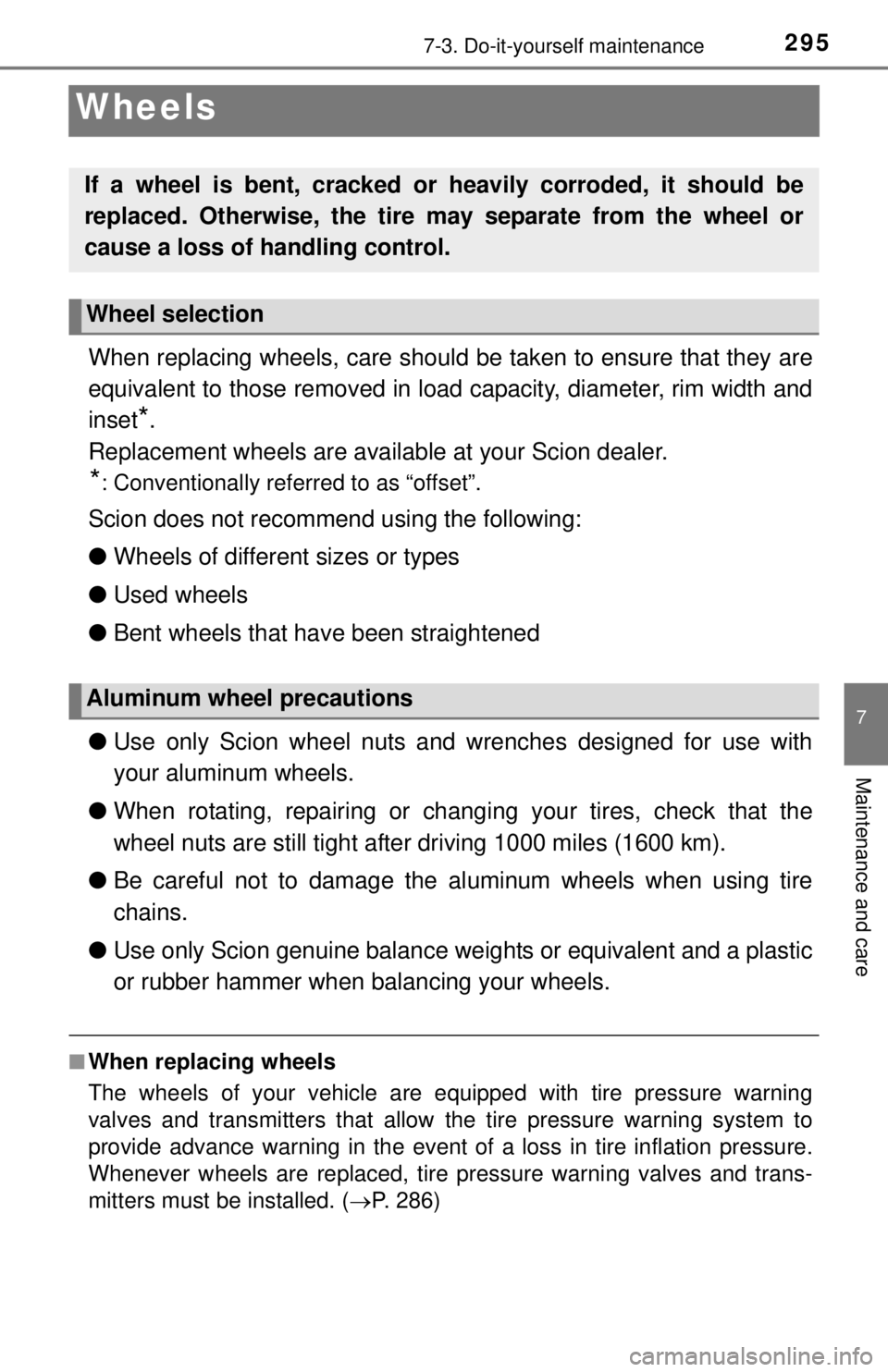
2957-3. Do-it-yourself maintenance
7
Maintenance and care
Wheels
When replacing wheels, care should be taken to ensure that they are
equivalent to those removed in load capacity, diameter, rim width and
inset
*.
Replacement wheels are available at your Scion dealer.
*: Conventionally referred to as ŌĆ£offsetŌĆØ.
Scion does not recommend using the following:
ŌŚÅ Wheels of different sizes or types
ŌŚÅ Used wheels
ŌŚÅ Bent wheels that have been straightened
ŌŚÅ Use only Scion wheel nuts and wrenches designed for use with
your aluminum wheels.
ŌŚÅ When rotating, repairing or changi ng your tires, check that the
wheel nuts are still tight after driving 1000 miles (1600 km).
ŌŚÅ Be careful not to damage the aluminum wheels when using tire
chains.
ŌŚÅ Use only Scion genuine balance weights or equivalent and a plastic
or rubber hammer when balancing your wheels.
Ō¢ĀWhen replacing wheels
The wheels of your vehicle are equipped with tire pressure warning
valves and transmitters that allow the tire pressure warning system to
provide advance warning in the event of a loss in tire inflation pressure.
Whenever wheels are replaced, tire pressure warning valves and trans-
mitters must be installed. ( ’é«P. 286)
If a wheel is bent, cracked or heavily corroded, it should be
replaced. Otherwise, the tire may separate from the wheel or
cause a loss of handling control.
Wheel selection
Aluminum wheel precautions
Page 296 of 444
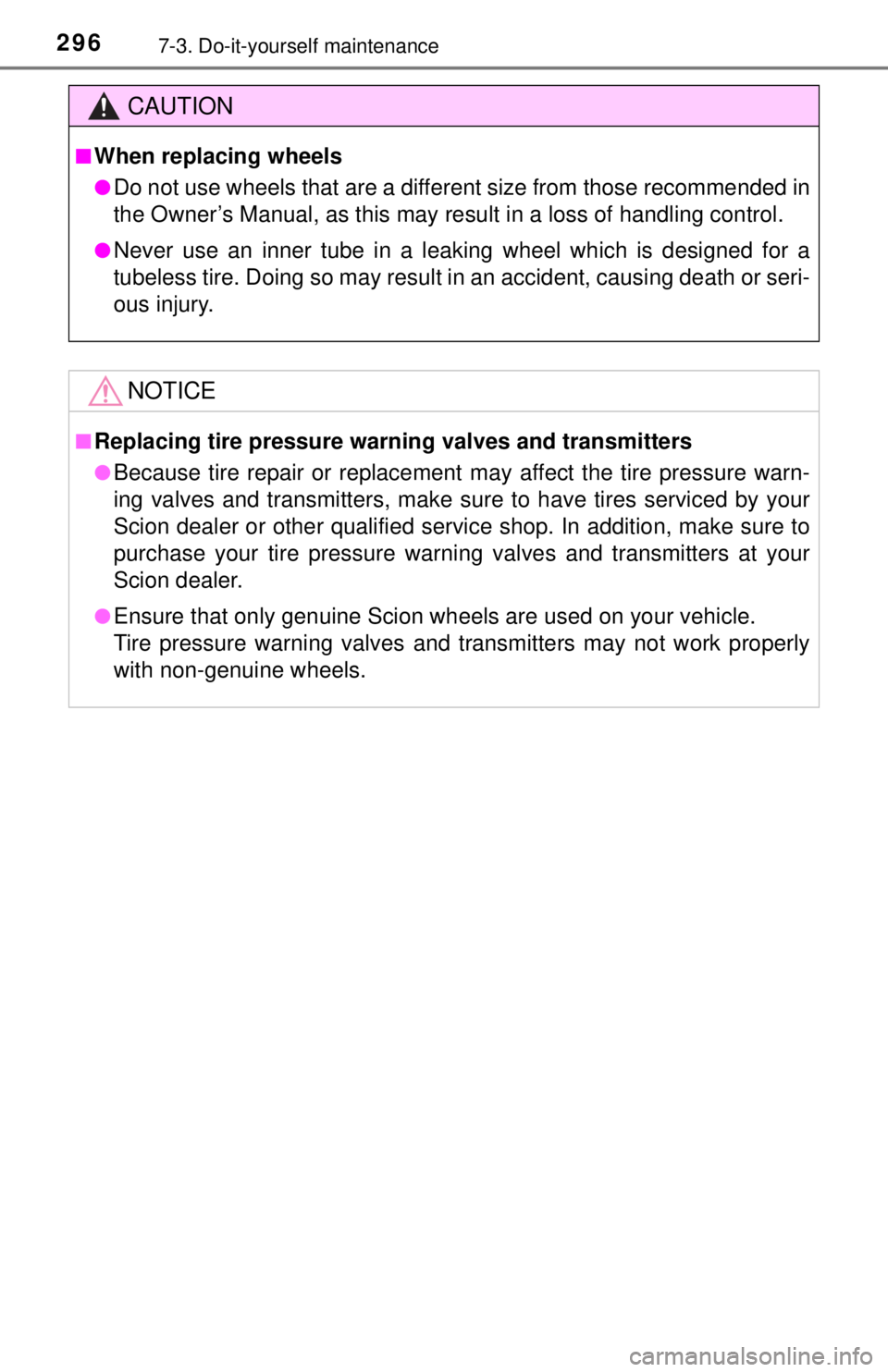
2967-3. Do-it-yourself maintenance
CAUTION
Ō¢ĀWhen replacing wheels
ŌŚÅDo not use wheels that are a different size from those recommended in
the OwnerŌĆÖs Manual, as this may result in a loss of handling control.
ŌŚÅNever use an inner tube in a leaking wheel which is designed for a
tubeless tire. Doing so may result in an accident, causing death or seri-
ous injury.
NOTICE
Ō¢ĀReplacing tire pressure warning valves and transmitters
ŌŚÅBecause tire repair or replacement may affect the tire pressure warn-
ing valves and transmitters, make sure to have tires serviced by your
Scion dealer or other qualified service shop. In addition, make sure to
purchase your tire pressure warning valves and transmitters at your
Scion dealer.
ŌŚÅEnsure that only genuine Scion wheels are used on your vehicle.
Tire pressure warning valves and transmitters may not work properly
with non-genuine wheels.
Page 370 of 444

3708-2. Steps to take in an emergency
Ō¢ĀIn the following cases, the tire cannot be repaired with the emer-
gency tire puncture repair kit. Contact your Scion dealer.
ŌŚÅWhen the tire is damaged due to driving without sufficient air pressure
ŌŚÅWhen there are any cracks or damage at any location on the tire, such
as on the side wall, except the tread
ŌŚÅWhen the tire is visibly separated from the wheel
ŌŚÅWhen the cut or damage to the tread is 0.16 in. (4 mm) long or more
ŌŚÅWhen the wheel is damaged
ŌŚÅWhen two or more tires have been punctured
ŌŚÅWhen more than 2 sharp objects such as nails or screws have passed
through the tread on a single tire
ŌŚÅWhen the sealant has expired
Ō¢ĀEmergency tire puncture repair kit
ŌŚÅThe sealant stored in the emergency tire puncture repair kit can be used
only once to temporarily repair a single tire. If the sealant has been used
and needs to be replaced, purchas e a new bottle at any authorized
Scion dealer. The compressor is reusable.
ŌŚÅThe sealant can be used when the outside temperature is from -40 ’é░F
(-40 ’é░C) to 140 ’é░F (60 ’é░C).
ŌŚÅThe repair kit is exclusively designed for size and type of tires originally
installed on your vehicle. Do not use it for tires that a different size than
the original ones, or for any other purposes.
ŌŚÅThe sealant has a limited lifespan. The expiry date is shown on the bot-
tle. The sealant should be replaced before the expiry date. Purchase a
new bottle at your Scion dealer for replacement.
ŌŚÅIf the sealant gets on your clothes, it may stain.
ŌŚÅIf the sealant adheres to a wheel or the surface of the vehicle body, the
stain may not be removable if it is not cleaned at once. Immediately wipe
away the sealant with a wet cloth.
ŌŚÅDuring operation of the repair kit, a loud operation noise is produced.
This does not indicate a malfunction.
ŌŚÅDo not use to check or to adjust the tire pressure.
Page 373 of 444

3738-2. Steps to take in an emergency
8
When trouble arises
CAUTION
Ō¢ĀDriving to spread the liquid sealant evenly
Observe the following precautions to reduce the risk of accidents.
Failure to do so may result in a loss of vehicle control and cause death
or serious injury.
ŌŚÅDrive the vehicle carefully at a low speed. Be especially careful when
turning and cornering.
ŌŚÅIf the vehicle does not drive strai ght or you feel a pull through the
steering wheel, stop the vehicle and check the following:
ŌĆó Tire condition. The tire may have separated from the wheel.
ŌĆó Tire inflation pressure. If tire inflation pressure is 19 psi (130 kPa, 1.3 kgf/cm
2 or bar) or less, this may indicate severe tire damage.
Ō¢ĀCaution while driving
ŌŚÅStore the repair kit in the luggage room.
Otherwise, the repair kit may fly out and break in events such as sud-
den braking, and may cause an accident.
ŌŚÅThe repair kit is exclusively only for your vehicle.
Do not use repair kit on other vehicles, which could lead to an accident
causing death or serious injury.
ŌŚÅDo not use repair kit for tires that are different size than the original
ones, or for any other purpose. If the tires have not been completely
repaired, it could lead to an accident causing death or serious injury.
Page 400 of 444
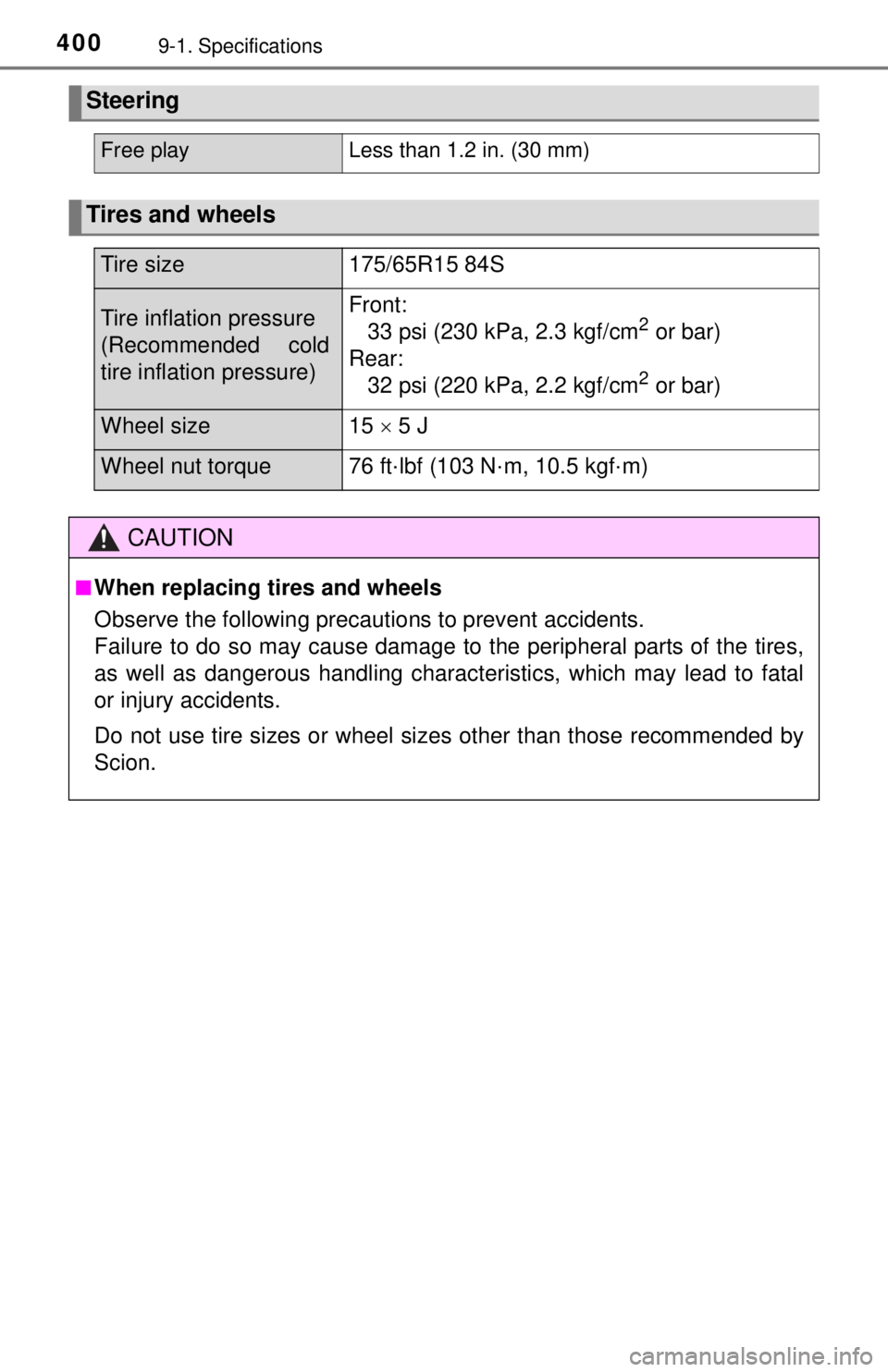
4009-1. Specifications
Steering
Free playLess than 1.2 in. (30 mm)
Tires and wheels
Tire size175/65R15 84S
Tire inflation pressure
(Recommended cold
tire inflation pressure)Front:33 psi (230 kPa, 2.3 kgf/cm2 or bar)
Rear: 32 psi (220 kPa, 2.2 kgf/cm
2 or bar)
Wheel size15 ’é┤ 5 J
Wheel nut torque76 ft┬Ęlbf (103 N┬Ęm, 10.5 kgf┬Ęm)
CAUTION
Ō¢ĀWhen replacing tires and wheels
Observe the following precautions to prevent accidents.
Failure to do so may cause damage to the peripheral parts of the tires,
as well as dangerous handling characte ristics, which may lead to fatal
or injury accidents.
Do not use tire sizes or wheel sizes other than those recommended by
Scion.